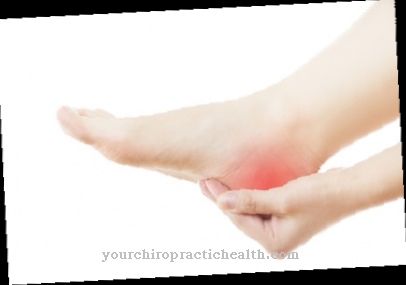If the surroundings are so blurred in front of a person that they can only perceive a lot of it in a foggy way, one speaks of the so-called Veil vision. As a symptom of various eye diseases, it can appear both gradually and suddenly in the person affected. At the first signs of veil vision, a doctor should be contacted immediately in order to diagnose the cause of the veil vision and to prevent further impairment.
What is veil vision?

Veiled vision is an impairment of the ability to see, which can primarily be expressed by a blurring of contrasts as well as extreme blurring and resulting from various causes.
Veil vision gets its name from the fact that humans only see their environment as though through a veil. In addition, the person affected can perceive rings, shadows, stripes or the so-called "black mosquitoes". The appearance of veil vision can develop in a slow disease process, but it can also develop suddenly in humans.
Above all, a sudden appearance of the veil is usually associated with serious symptoms such as severe headache and eye pain, so that a doctor should be consulted immediately.
causes
Veiled vision can have many different causes. However, it is primarily caused by certain diseases of the eye. In addition to vitreous and retinal detachments, macular degeneration and vitreous hemorrhage, cataracts can also be counted.
This eye disease, also known as cataract, describes a slowly progressing clouding of the lens in old age, the cause of which has not yet been precisely clarified. In addition to cataracts, however, glaucoma can also be seen as a cause of veil vision. In addition to extreme eye, head and stomach pain, a sight of rainbow-like patterns around light sources can suddenly appear.
These sudden symptoms are grouped together in medicine as glaucoma attacks and should be treated immediately. In addition to eye diseases, however, other diseases that are not immediately associated with the eye can also be seen as a possible cause of haze vision. For example, diabetes mellitus can also cause blurred vision.
You can find your medication here
➔ Medicines for visual disturbances and eye complaintsDiseases with this symptom
- Retinal detachment
- Systemic lupus erythematosus (SLE)
- Age-related macular degeneration
- Diabetes mellitus
- Cataract
- Drug allergy
Diagnosis & course
An ophthalmologist should be contacted immediately in the event of sudden or slow appearance of the veil vision in order to diagnose possible causes of the veil vision and to remedy them as soon as possible.
Typical diagnostic procedures include eye tests with a measurement of intraocular pressure and diagnostic imaging procedures to assess the optic nerve in the fundus. In the diagnosis of a macular degeneration, the so-called Amsler grid test is used, in which the patient is supposed to assess a special grid while simultaneously covering one eye.
In the case of special diseases of the eye, which are systemically caused, the underlying disease must first be searched for and then treated. In the diagnosis, however, other causes such as diabetes mellitus, which initially do not directly affect the eyes, should always be considered.
Complications
Veiled vision should definitely be treated by a doctor as it can be a serious disease of the eyes. Even if veiled vision only occurs for a short time, it should definitely be examined carefully by a doctor. As a rule, veiled vision is triggered by various eye diseases, which is why there is no universal prediction of the complications of this symptom.
In most cases, these diseases are cataracts or glaucoma. These diseases occur in old age, which is why veiled vision also occurs in old age. There is usually no surgical intervention. Pain rarely occurs with blurred vision, but the patient's eyesight is reduced, which is why a visual aid must be worn.
Most of the time, blurred vision can be remedied relatively easily; treatment with medication is provided. To prevent the symptom in general, older people in particular should have their eyes checked regularly. With early detection, the treatment of veiled vision is very simple and does not lead to any other consequential damage. There is no consolidation during treatment.
When should you go to the doctor?
If the patient has veiled vision often and occurs over a longer period of time or even permanently, a doctor must be consulted urgently. This can be a serious illness that definitely needs to be investigated and treated. In many cases, veiled vision also occurs with a migraine.
If the symptom disappears on its own after a short period of time and does not lead to further symptoms, a visit to the doctor is usually not necessary. A medical examination is also necessary if the patient suffers from other symptoms of the eyes in addition to veiled vision. This can be a cataract or detachment of the retina on the eye. These complaints must be treated as quickly as possible so that there are no consequential damages or complications.
If veiled vision occurs as a result of stress, the patient can primarily reduce the stress and thereby limit the symptom. Psychological causes are treated by a psychologist. If veiled vision is associated with other eye complaints, an ophthalmologist can be consulted directly. However, if the patient is not sure about the cause of the symptom, they can go to the family doctor first.
Doctors & therapists in your area
Treatment & Therapy

Depending on the cause of the veil, different therapeutic approaches can be used with the affected person. First of all, the surgical procedures should be mentioned, which are used, for example, in the treatment of cataracts. During the operation, the clouded lens is removed at the beginning before an artificial lens is inserted by the ophthalmologist.
Alternatively, the compromised lens can be removed with a laser. The artificial lens inserted should then enable the patient to have largely complete vision again. While cataracts can usually be easily removed surgically due to their characteristic symptoms, glaucoma often goes unnoticed for a long time and can therefore be diagnosed too late. If glaucoma is already manifest, it is again necessary to reduce the intraocular pressure immediately to prevent possible blindness.
The reduction can take place surgically, but also with medication. Chronic open-angle glaucoma, for example, responds positively to drug treatment. It is important, however, that this must be carried out for life in order to avoid increased accumulation of aqueous humor. If the veil of vision is based on systemic causes, the other basic disorders must be treated in addition to the disease of the eye.
Outlook & forecast
If vision is cloudy, the patient should definitely consult a doctor and have the symptom treated. Usually it is a serious cause that definitely needs treatment and will not go away on its own.
Most of the time, the eyesight is reduced by the blurred vision. The person affected can no longer clearly see outlines and shapes and therefore needs a visual aid in order to be able to cope with everyday life on their own. Veil vision usually only occurs in old age, which is a progressive process.
If veil vision occurs suddenly and at a young age, a doctor must be consulted in any case. A visit to the doctor is also necessary if veiled vision occurs after an accident or after a blow to the head.
If the veil of vision is triggered by a disease in the eye, this can be treated relatively easily in most cases. Operative interventions may be necessary here. Early treatment is important to avoid visual impairment and other complications. Without treatment, blurred vision will not go away on its own and have a negative effect on eyesight.
You can find your medication here
➔ Medicines for visual disturbances and eye complaintsprevention
To prevent veiled vision, it is important to visit an ophthalmologist at regular intervals for special preventive examinations. Here eye tests and other examinations of the eyes and eyesight take place, which can diagnose a possible occurrence of veiled vision and the associated disease at an early stage.
In addition to visiting the doctor, however, a healthy lifestyle in everyday life can also help counteract veiled vision. For example, arteriosclerotic changes can be prevented. Eye diseases that cause blurred vision cannot be completely avoided in this way.
You can do that yourself
There is no specific self-help treatment for veiled vision. If the cause is cataracts, cataracts or glaucoma or another disease of the eye, this must be examined and treated by an ophthalmologist.
In general, a healthy lifestyle has positive effects on healing for veil vision. This includes eating a healthy diet and exercising regularly. Obesity should also be avoided if possible.
The eye itself must also be spared. Avoid prolonged work on the computer or smartphone. Stress and unnecessary exertion should also be avoided. A high intake of fluids and the avoidance of alcohol, cigarettes and other drugs help against veiled vision. Especially diabetics should pay attention to a healthy lifestyle.
To prevent veiled vision, patients should take regular examinations. This is especially true for people of old age and for those suffering from diabetes. Here, the cause can be recognized and treated at an early stage so that veiled vision does not even occur. In general, visual aids should always be worn with poor eyesight. This prevents the muscles from exerting themselves and the poor eyesight from worsening.



























